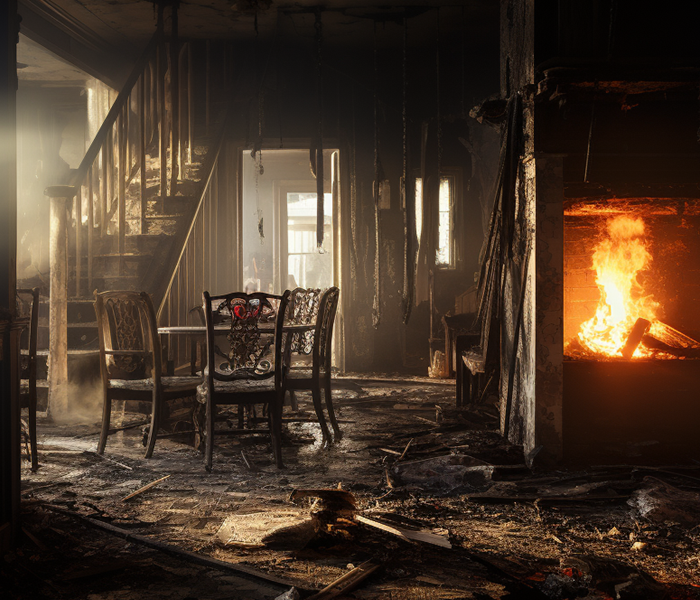Steps to Take After Experiencing Fire Damage
2/9/2024 (Permalink)
Experiencing a house fire can be a devastating and traumatic event, but with the right knowledge and action plan, you can start the journey towards recovery. At Team Shaw, we understand the challenges that come with fire damage and are here to guide you through the process of restoration. In this blog post, we'll provide detailed and actionable tips for what to do after experiencing fire damage, as well as best practices for preventing house fires altogether.
After Experiencing Fire Damage:
Safety First:
- Before entering your home, ensure that it is safe to do so. Contact local authorities and firefighters to confirm that the fire is completely extinguished and that the structure is stable.
- Wear appropriate protective gear, including gloves, masks, and sturdy shoes, to protect yourself from hazards such as debris and smoke residue.
Assess the Damage:
- Once it's safe to enter your home, assess the extent of the fire damage. Take note of areas that are severely affected, including structural damage, charred materials, and smoke residue.
- Document the damage by taking photos and videos. This documentation will be invaluable for insurance claims and restoration efforts.
Contact Professionals:
- Reach out to experienced professionals like Team Shaw for fire damage restoration services. Our team has the expertise and resources to assess the damage, salvage belongings, and restore your home to its pre-fire condition.
- Avoid attempting DIY repairs, as improper restoration efforts can worsen the damage and pose safety risks.
Secure the Property:
- Board up windows, doors, and other openings to secure the property and prevent unauthorized access.
- Cover any exposed areas with tarps or plastic sheeting to protect against further damage from weather elements.
Mitigate Smoke Damage:
- Smoke residue can permeate walls, furniture, and belongings, leading to lingering odors and health hazards. Ventilate the affected area by opening windows and using fans to remove smoke odor and improve air quality.
- Professional cleaning and deodorization services can effectively remove smoke residue and restore a clean, safe living environment.
Dispose of Damaged Items:
- Dispose of severely damaged or unsalvageable items properly. This may include furniture, appliances, and personal belongings that have been charred or contaminated by smoke and soot.
- Work with professionals to handle hazardous materials and ensure proper disposal according to local regulations.
Work with Insurance:
- Contact your insurance provider to report the fire damage and initiate the claims process. Provide thorough documentation, including photos, videos, and inventory lists of damaged items.
- Keep records of all communication with your insurance company and any expenses incurred during the restoration process.
Best Practices for Preventing House Fires:
Install Smoke Alarms:
- Install smoke alarms on every level of your home and inside each bedroom. Test smoke alarms regularly and replace batteries as needed.
Practice Fire Safety:
- Avoid leaving cooking appliances unattended while in use. Keep flammable materials such as dish towels and curtains away from stovetops.
- Never leave candles burning unattended, and keep them away from flammable materials.
- Use caution when using space heaters, ensuring they are placed on a stable surface away from flammable materials and turned off when not in use.
Maintain Electrical Systems:
- Inspect electrical outlets, wiring, and appliances regularly for signs of wear or damage. Replace frayed cords and malfunctioning appliances promptly.
- Avoid overloading electrical outlets and extension cords, and use surge protectors when necessary.
Practice Caution with Smoking Materials:
- If you smoke, do so outdoors and use designated ashtrays. Ensure that cigarette butts are fully extinguished before disposal.
- Never smoke in bed or while drowsy, as it increases the risk of accidental fires.
Have an Escape Plan:
- Create a fire escape plan for your family and practice it regularly. Identify multiple escape routes from each room and establish a meeting point outside the home.
By following these steps and implementing best practices for fire prevention, you can help protect your home and loved ones from the devastating effects of house fires. Remember, Team Shaw is here to support you in the event of fire damage, providing professional restoration services and helping you rebuild and recover. Stay safe and prepared!





 24/7 Emergency Service
24/7 Emergency Service
